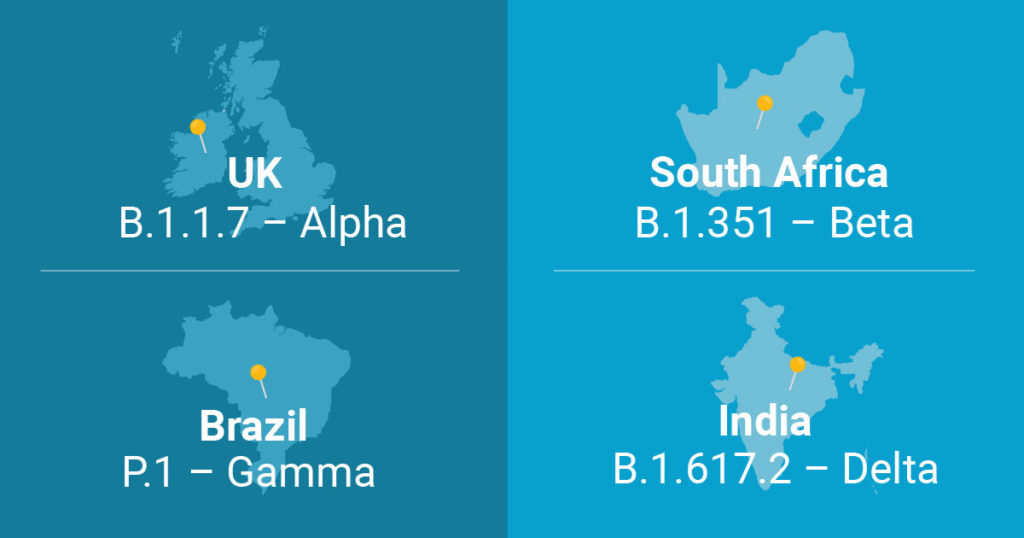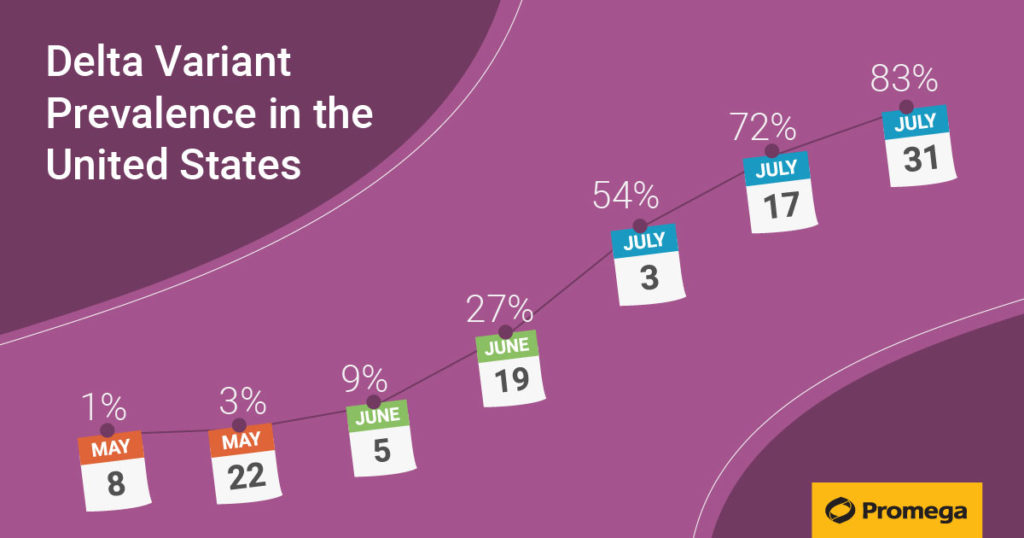The Delta Variant poses a unique challenge to global health. We’ve compiled answers to some of the most common questions about Delta and other SARS-CoV-2 variants.
What is a variant?
A variant is a form of a virus that is genetically distinct from the original form.
“All organisms have mutation rates,” says Luis A Haddock, a graduate student at University of Wisconsin – Madison. “Unfortunately for us, viruses have one of the highest mutation rates of everything that currently exists. And even more unfortunately, RNA viruses have the highest mutation rates even among viruses.”
Luis works in the Friedrich Lab at UW-Madison, which has been sequencing SARS-CoV-2 genomes from positive test samples since the beginning of the pandemic. SARS-CoV-2 is constantly evolving, and sequencing can help us follow it through time and space. Most of the variants don’t behave any differently. A single nucleotide substitution might not even change the amino acid sequence of an encoded protein. However, occasionally a mutation will alter the structure or function of a protein.
Learn more about SARS-CoV-2 sequencing in the article “From Primate Models to SARS-CoV-2 Sequencing and Testing,” featuring David and Shelby O’Connor, two collaborators of the Friedrich Lab.
What is a Variant of Concern?
When a circulating variant displays a mutation that is suspected to confer some sort of advantage, the variant is classified as a Variant of Interest (VOI). This label marks variants that might present unique public health challenges and require further monitoring and investigation.
When a variant is shown to behave differently in a population, it becomes a Variant of Concern (VOC). The CDC lists five factors that a VOC might display:
- Increase in transmissibility
- More severe disease
- Significant reduction in neutralization by antibodies generated during previous infection or vaccination
- Reduced effectiveness of treatments or vaccines
- Diagnostic detection failures
Learn more about viral evolution and variants in the article “What Is A Viral Variant?”
How many SARS-CoV-2 variants are there?
“We see many mutations incorporated into different sequences from different individuals,” Luis says, “but that doesn’t mean that there will be a new variant rising out of nowhere. We find nucleotide changes are more common than amino acid changes.”
Sequencing data is arranged into phylogenetic trees to monitor how different lineages are evolving over time. Data generated by the Friedrich Lab and the O’Connor Lab shows hundreds of variants in Wisconsin alone.
Compared to the number of different genome sequences circulating throughout the world, there are few variants that become VOIs or VOCs. At this time, CDC is monitoring 6 VOIs and 4 VOCs. The Delta Variant, also known as B.1.617.2, is the most recent VOC to spread rapidly around the world.
There is one designation above Variant of Concern: Variant of High Consequence. This designation indicates that the variant evades the prevention measures and medical countermeasures that were effective against previous variants. There currently are no SARS-CoV-2 Variants of High Consequence.

What is the Delta Variant?
The Delta Variant was first identified in India in December 2020 and has since spread to at least 132 countries. It has approximately 15 amino acid substitutions compared to the ancestral form of SARS-CoV-2. The Delta Variant was first detected in the United States on February 22, 2021, and by the end of July, Delta accounted for over 80% of new COVID-19 cases in the U.S. Delta has prompted many areas to restore actions such as mask mandates.
“In May and June of this year, we saw a major shift from B.1.1.7 to B.1.617.2,” says Luis. “Since then, the majority of the cases that we sequence in our facilities are the Delta variants.”

Bonus Question: Why is it called the Delta Variant?
In May 2021, WHO announced that it was implementing a new system for naming variants using letters of the Greek alphabet. The goal was to create labels that are simple and easy to remember, to create more clarity in communication. B.1.1.7, the VOC first documented in the United Kingdom, was assigned Alpha. At this time, there are variants corresponding to every letter up to lambda, though zeta, theta and kappa have been shown to no longer pose a major threat.
Why is the Delta Variant particularly concerning?
Delta has become the dominant variant worldwide in a very short time. It has replaced B.1.1.7 in most areas, and daily case numbers have risen substantially.
Delta is significantly more transmissible than other VOCs – as much as 60% more transmissible than B.1.1.7. CDC also suggests that it might be less susceptible to neutralization by existing monoclonal antibody treatments and antibodies elicited by vaccines.
Over 4 billion vaccine doses have been administered worldwide, but the majority of the global population still has not had their first dose. In the United States, for example, 52% of the population is unvaccinated. Even setting aside questions about vaccine efficacy against Delta, the potential for another massive wave of infections is startling. It’s crucial that we all stay aware of the guidelines and recommendations from public health organizations such as CDC.
Do RT-PCR tests still detect new SARS-CoV-2 variants?
There is no specific reason why a PCR test would not detect a SARS-CoV-2 VOC such as Delta. Most test systems include primers for multiple loci, and a primer can still bind even if there is a mismatched nucleotide in the sequence. In addition, most of the mutations that confer functional changes to VOCs such as Delta are located in the Spike protein. Commercially available RT-PCR tests might a variety of specific sequences in the genome, but CDC and other infectious disease organizations recommend focusing on highly conserved regions such as the sequences encoding the Nucleocapsid protein.
There is concern that as the pandemic progresses and SARS-CoV-2 accumulates more mutations, certain RT-PCR tests might begin to show more false negatives. The United States Food and Drug Administration (FDA) monitors the tests that have received Emergency Use Authorization (EUA) and issues reports on tests with impacted performance.
Learn more about RT-PCR COVID-19 testing in the article “Testing for COVID-19: How it Works.“
Special thanks to Luis A. Haddock, a third-year PhD student in the Friedrich Lab at UW-Madison, for providing information and resources for this article.
Promega supplies reagents, assays and benchtop instruments essential for COVID-19 research, drug development and diagnostic testing. Learn how we’re supporting the fight against COVID-19 in our Corporate Responsibility Report.
Latest posts by Jordan Villanueva (see all)
- Raising Frogs Takes a Village: Accelerating Amphibian Research at the Marine Biological Laboratory - January 9, 2024
- Coral, Ferrets and a Lot of Elephant Poop: 5 Years of the Revive & Restore Catalyst Science Fund - December 14, 2023
- The R&D Flex Team: A Unique Research Scientist Opportunity - October 17, 2023
